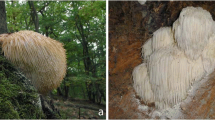Abstract
This present study was performed to investigate estrogenic activity of Korean edible wild plants for alternative of estrogen replacement therapy in postmenopausal women. When the estrogenic activity was measured by estrogen induced proliferation of MCF-7 cells, of investigated 29 extracts, 3 samples of kudzu vine (Pueraria thunbergiana), Cardamine leucantha, and David Vetchling (Lathyrus davidii) exhibited a significant proliferation of above 20% at concentration of 100 μg/mL. This stimulation of MCF-7 cell proliferation could be completely blocked by addition of estrogen antagonist ICI 182,780 (100 nM), indicating estrogen receptor-dependent mechanism of these estrogenic effects on MCF-7 cell proliferation.
Similar content being viewed by others
References
Kannel WB, Levy D. Menopause, hormones, and cardiovascular vulnerability in women. Arch. Intern. Med. 164: 479–481 (2004)
Carr MC. The emergence of the metabolic syndrome with menopause. J. Clin. Endocr. Metab. 88: 2404–2411 (2003)
Hill K. The demography of menopause. Maturitas 23: 113–127 (1996)
Grady D, Rubin SM, Petitti DB, Fox CS, Black D, Ettinger B, Ernster VL, Cummings SR. Hormone-therapy to prevent disease and prolong life in postmenopausal women. Ann. Intern. Med. 117: 1016–1037 (1992)
Persson I, Weiderpass E, Bergkvist L, Bergstrom R, Schairer C. Risks of breast and endometrial cancer after estrogen and estrogenprogestin replacement. Cancer Cause Control 10: 253–260 (1999)
Murkies AL, Wilcox G, Davis SR. Clinical review 92-phytoestrogens. J. Clin. Endocr. Metab. 83: 297–303 (1998)
Davis SR, Dalais FS, Simpson ER, Murkies AL. Phytoestrogens in health and disease. Recent Prog. Horm. Res. 54: 185–211 (1999)
Doyle BJ, Mahady GB. Phytomedicines for menopause. Drug Future 32: 897–905 (2007)
Cassidy A. Potential risks and benefits of phytoestrogen-rich diets. Int. J. Vitam. Nutr. Res. 73: 120–126 (2003)
Mueller SO. Overview of in vitro tools to assess the estrogenic and antiestrogenic activity of phytoestrogens. J. Chromatogr. B 777: 155–165 (2002)
Villalobos M, Olea N, Brotons JA, Oleaserrano MF, Dealmodovar JMR, Pedraza V. The E-screen assay — a comparison of different MCF7 cell stocks. Environ. Health Persp. 103: 844–850 (1995)
Sonnenschein C, Soto AM. An updated review of environmental estrogen and androgen mimics and antagonists. J. Steroid Biochem. 65: 143–150 (1998)
Soto AM, Sonnenschein C, Chung KL, Fernandez MF, Olea N, Serrano FO. The E-screen assay as a tool to identify estrogens: An update on estrogenic environmental pollutants. Environ. Health Persp. 103: 113–122 (1995)
Kim SJ, Park C, Kim HG, Sin WC, Choe SY. A study on the estrogenicity of Korean arrowroot (Pueraria thunbergiana). J. Korean Soc. Food Sci. Nutr. 33: 16–21 (2004)
Yang F, Su YF, Bi YP, Xu J, Zhu ZQ, Tu GZ, Gao XM. Three new kaempferol glycosides from Cardamine leucantha. Helv. Chim. Acta 93: 536–541 (2010)
Park SY, Kim JS, Lee SY, Bae KH, Kang SS. Chemical constituents of Lathyrus davidii. Nat. Prod. Sci. 14: 281–288 (2008)
Cherdshewasart W, Traisup V, Picha P. Determination of the estrogenic activity of wild phytoestrogen-rich Pueraria mirifica by MCF-7 proliferation assay. J. Reprod. Develop. 54: 63–67 (2008)
Hu Y, Hou TT, Zhang QY, Xin HL, Zheng HC, Rahman K, Qin LP. Evaluation of the estrogenic activity of the constituents in the fruits of Vitex rotundifolia L. for the potential treatment of premenstrual syndrome. J. Pharm. Pharmacol. 59: 1307–1312 (2007)
Maggiolini M, Statti G, Vivacqua A, Gabriele S, Rago V, Loizzo M, Menichini F, Amd S. Estrogenic and antiproliferative activities of isoliquiritigenin in MCF7 breast cancer cells. J. Steroid Biochem. 82: 315–322 (2002)
Zava DT, Duwe G. Estrogenic and antiproliferative properties of genistein and other flavonoids in human breast cancer cells in vitro. Nutr. Cancer 27: 31–40 (1997)
Author information
Authors and Affiliations
Corresponding author
Rights and permissions
About this article
Cite this article
Lee, Y.M., Jung, H.Y., Bae, J.H. et al. Screening of Korean edible wild plants for estrogenic activity using MCF-7 cell proliferation assay. Food Sci Biotechnol 20, 829–833 (2011). https://doi.org/10.1007/s10068-011-0115-5
Received:
Revised:
Accepted:
Published:
Issue Date:
DOI: https://doi.org/10.1007/s10068-011-0115-5




